By Jasmine Zamora
When many people think of fungi, they first envision beautiful fruiting bodies that grow out of the damp grass and soil. However, there is a much darker side of the kingdom fungi that can cause sickness and death. The members of the Aspergillus genus do not grow on recently rained-on terrain, nor do they need a specific temperature to grow in. These are molds, most familiarly Aspergillus niger, can in some cases cause disease in humans, animals and plants.
Aspergillus niger isn’t as notoriously dangerous as Aspergillus fumigatus, which is the most prevalent airborne fungal pathogen (Latgé 1999). However, Aspergillus niger contains toxins that can make people with weak immune systems become very sick and can sometimes result in death. These toxins can be inhaled by humans, most commonly people who work around plants or peat, and can cause a lung disease called Aspergillosis, which has infected over 300,000 people worldwide (Keir 2013). Aspergillus niger is not one of those that are so deadly, but can definitely cause sickness and allergic reactions. Aspergillus niger is an asexual saprophytic fungus that can grow on dead leaves, stored grain, compost piles and other decaying vegetation. A. niger is a very thermotolerant fungus that can thrive in freezing conditions and very hot weather (Metzger 2008). It produces its spores on an asexual structure called the conidium. The spores can be inhaled when simply working with anything A. niger has colonized.
Aspergillus niger contains several toxins, some harmless and others harmful to certain people. The main toxins it contains are malformin C, and ochratoxin A. A. niger can be as beneficial as it is harmful, though. Through fermentation, it can produce useful enzymes that can be used in the production of corn syrup, Beano, wine and cider (Rajkumar 2010).
Fortunately, most people can handle the inhalation of a moderate amount of A. niger spores. Aspergillus spores are in the air we breathe almost everywhere we go. It is those who suffer from leukemia, HIV or AIDS, severe fungal allergies and other immune deficiencies that could become very sick to the intake of A. niger spores (Bartholomew 2009). There has actually been a case where a 70 year old man had to have his foot amputated because there was a “painful black ‘gangrenous appearing’ mass on his foot. “Tissue samples showed not only branching hyphae, but dark pigmented fungal fruiting heads with double sterigmata in which Aspergillus niger was identified” (EPA.gov). This may be a case of a sickly man that was just unfortunate enough to come into contact with A. niger, but the so-called “harmless” fungi can effect healthy people in rare cases. Otomycosis, an ear infection that can be very painful, can be caused by Aspergillus niger. Allergic reactions can be severe when an individual that is very allergic to fungi. “When inhaled, A. niger can cause hypersensitivity reactions such as asthma and allergic alveolitis” (EPA.gov). This is uncommon, but nearly fatal if the wrong person became infected.
A. niger can also affect plants, such as onions and tomatoes. Small animals, such as mice and chicks were fed moldy soybeans with A. niger on them, and the subjects subsequently died after digestion (EPA.gov). Onions are a common plant that A. niger likes to inhabit, causing spoilage and can then result in economic loss in farming communities. Mangoes, grapes and tomatoes are also victims of the pathogen, as well as 34 other genera of plants. Lastly, A. niger can cause the rotting of wood and other hard surfaces. Wood surfaces have been found softening or deteriorating because of the contamination of A. niger. There have also been reports of A. niger effecting very random substrates such as polyvinyl acetate, polyester-type polyurethanes, and even English style crumpets.
Aspergillus niger does not discriminate when it comes to what it w ants to contaminate. However, this very durable fungus is nothing to be worried about, unless you have a weak immune system or have a sensitive allergy to fungi, or if you are a mouse. There are also remedies that can be taken if one contracts Otomycosis or another common fungal infection. There are many other more harmful fungi that are in the same family (A. fumigatus) to be worried about, so be sure you don’t inhale too many A. niger spores, and don’t eat heavily molded fruits that are covered in a black substance, and you should be fine.
ants to contaminate. However, this very durable fungus is nothing to be worried about, unless you have a weak immune system or have a sensitive allergy to fungi, or if you are a mouse. There are also remedies that can be taken if one contracts Otomycosis or another common fungal infection. There are many other more harmful fungi that are in the same family (A. fumigatus) to be worried about, so be sure you don’t inhale too many A. niger spores, and don’t eat heavily molded fruits that are covered in a black substance, and you should be fine.
Works Cited
Anonymous. 1997. Aspergillus niger Final Risk Assessment. Biotechnology program under toxic substances control act (TSCA) U.S. Environmental Protection Agency U.S.A. 3171.
Corrigan. (October 15, 2009). Aspergillus niger. In Encyclopedia of Life. Retrieved January 28, 2014, from http://eol.org/pages/2920814/details.
Keir, G. J., Garfield, B., Hansell, D. M., Loebinger, M. R., Wilson, R., Renzoni, E. A., & Maher, T. M. (2013). Cyclical caspofungin for chronic pulmonary aspergillosis in sarcoidosis. Thorax, thoraxjnl-2013.
Latgé, J. P. (1999). Aspergillus fumigatus and aspergillosis. Clinical microbiology reviews, 12(2), 310-350.
Metzger, B. (November 16, 2008). Aspergillus niger . In Mushroom Observer. Retrieved January 28, 2014, from http://mushroomobserver.org/name/show_name/15030?_js=on&_new=true.
Paul, R., Singh, V., Tyagi, R., Singh, A., & Dubey, D. (2010). Micro-Elements work for the growth and total soluble protein production in Aspergillus niger at different concentrations. Journal of Pure and Applied Microbiology, 4, 293-296.
Sutton, D. A. 2005. Aspergillus niger. Retrieved February 10, 2014. from:http://www.doctorfungus.org.
SCIMAT. Aspergillus niger fungus. Retrieved February 10, 2014. from: http://viemxoang.vn/wp-content/uploads/2011/10/aspergillus_niger_fungus_aspergillus_niger_fungus_ah963a.jpg.
